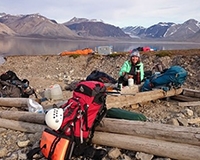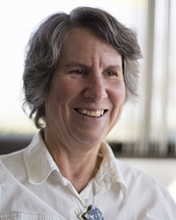Scientist Carries Interdisciplinary Spirit Across the Globe
 Professor Marilyn Fogel went from the heat of Africa to the chilly fjords of Norway this summer to lend her biogeochemical perspective to two international, interdisciplinary, intercollegiate research projects.
Professor Marilyn Fogel went from the heat of Africa to the chilly fjords of Norway this summer to lend her biogeochemical perspective to two international, interdisciplinary, intercollegiate research projects.
In May and June, Fogel worked with a team of geochemists and archaeologists from the University of Kansas, the University of Utah, Stirling University (Scotland) and Simon Fraser University (Canada) to examine soil samples from a dig site and study Ethiopia’s climate, fire history and ways humans have manipulated the land over the past 10,000 years.
“The archeologists had all the classic artifacts — bones, pottery shards, tools — and we came back with soil,” said Fogel, who’s with the School of Natural Sciences. “That area is the cradle of agriculture, and we can learn more about how humans evolved there and whether changes in Earth’s climate over this time period were related to how the civilizations evolved.”
Fogel and her team hired young Ethiopian men to use rock hammers to collect soil samples every 10 centimeters along a 6-meter cross section of sediment. She worked for three days at the local jail complex — the only place with a hose — washing samples to find charcoal for carbon dating.
The samples will provide volumes of information, including data on land use in the watershed, forest fires and the environment, to round out archeological examinations that have been carried out for more than 20 years. Adding geochemical information to the body of archeological evidence can provide a new window into how the Axumite and Pre-Axumite civilizations interacted with their environment.
“The team had found evidence of when people in the area converted to Christianity, clues about their society and lifestyles — it was a really neat intersection of two very different fields,” Fogel said.
Such intersections are common at UC Merced, where interdisciplinary research is a campus hallmark. The combination of disciplines brings a much rounder view of the research than any discipline would have alone.
Fogel’s soil samples are now at UC Merced, along with sample bones from animal burial sites. She will use isotope ratio mass spectrometers to measure organic matter and plant fragments in these soils and bones, so she can further understand climate changes in the area over time. She’ll also be able to tell when certain crops, like the Ethiopian grain teff, were introduced.
“We can learn about how society was functioning at the time by looking at whether the work animals — like goats, sheep and cows — were fed or whether they had to scavenge for whatever they could find on the ground,” she said.
Studying ‘Blueberries’ In the Arctic
After the Ethiopian trip, Fogel spent the last part of July in Svalbard, Norway, well above the Arctic Circle at 79 degrees north latitude, a place she had visited six times before.
It’s a Mars analog site — one of the places NASA has tested instrumentation and rovers for Mars missions, including two of the instruments currently roving Mars on Curiosity — and it’s home to an unusual rock formation that has fascinated Fogel and her colleagues for years.
Fogel’s previous trips were part of larger NASA projects. But she and her teammates, including astrobiologists, other biogeochemists and two Norwegian geologists, returned this year to study “blueberry rocks” — sedimentary rocks covered in dimples that resemble blueberries. Fogel and her team first investigated the rocks in 2004 and 2006, while testing glacial ice to see how it might compare with Martian polar ice.
The “blueberries,” called concretions, are small, round objects that are seen both on Earth and in similar types of rocks on Mars.
Between keeping watch for polar bears throughout the 24-hour daylight, the researchers gathered enough samples for each to bring several specimens home to labs in Germany, England, Norway and the United States.
In the field, they split open some of the mysterious rocks to discover that inside — often only on one side — there are spots that correspond to the dimples on the outside.
These spots contain cyanobacteria, though whether the bacteria are responsible for the “blueberries,” the researchers do not know. Over time, the blueberry-sized dimples and the spots inside the rocks turn to sand, collapsing into each other.
The researchers also want to know why that happens and whether living organisms are important for these formations. Each team member will conduct his or her own style of analysis, and the results will be compared and combined.
Fogel is hopeful she and her teammates will be able to solve some of the mysteries of the rocks, in part because of all the different angles from which they will study the questions.
“This is what happens when you put people from many different disciplines together, remove them from the distractions of email and cell phones, and let them immerse themselves in the natural world,” she said. “That’s where things really happen.”
